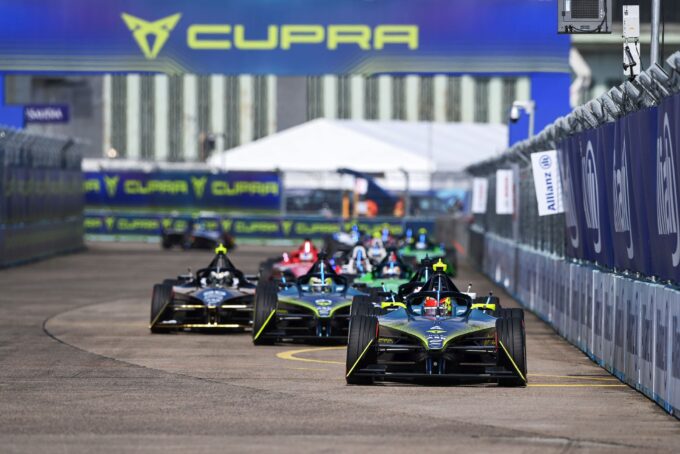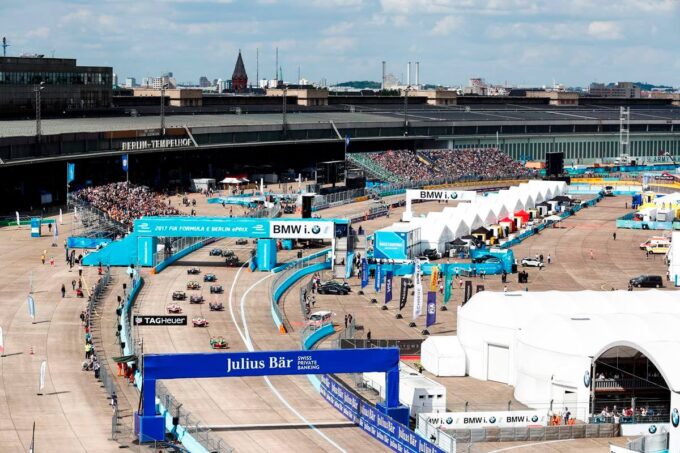Formula E: Nico Müller's rituals before the start 🎥
BACKGROUND The penultimate stop of Formula E in Rome offers fans a double-header event on Saturday and Sunday (July 15 and 16). ABT Cupra driver Nico Müller describes very personally how he is preparing.

A real heat battle and one of the most demanding tracks of the season await the ABT Cupra Formula E team in the Italian capital. ABT Cupra driver Nico Müller gives an insight into the procedures of a Formula E race and he reveals his rituals and tricks for starting fully concentrated.
Flashback to happiness
Semi-final of qualifying in Berlin: Nico Müller is pushed into the pits and looks into the faces of his team. "The air was crackling. You could see the sparkle in the eyes of the mechanics and engineers - it was pure happiness," says the Swiss ABT CUPRA Team driver, describing the scenes after reaching the qualifying final at the race in Berlin at the end of April (see gallery and video). In Rome, the ABT Cupra Team wants to build on this success. Nico Müller and team mate Robin Frijns (center gallery) know only too well what it takes to achieve this.
It all starts in the simulator
For Nico Müller, preparation for the race in Rome began shortly after the end of the last race in Portland (USA). "Analyzing the last race is already part of the preparation. You take away the lessons you've learned," he explains. Then, before the actual race weekend, it's first off to the simulator. The pilots get a first feel for the real course during the track inspection.
Nico Müller: "There, the teams have a slot where you walk the track. In Formula E, there are no permanent race tracks, so the walk-through is enormously important. You pay attention to every detail: where the asphalt changes, or where there might be a bump that you can't see from the cockpit."
Confidence in the vehicle
Once the track has been internalized, it's a matter of optimally tuning the race car. "The car is permanently tuned up to the race and the set-up is refined to adapt it optimally to the track conditions and my driving style. Together with the data collected, my input is very important in this process, because it's me who moves the car at the limit and has to have confidence in the material. I'm in close coordination with the race engineers and the performance engineer on this."
Nico calls these individual steps "warm-up" for the race. This includes shielding himself from the outside world in order to "get into the tunnel". "You have to leave everything else to the left on a race weekend. There's no room for anything else on a race day. You're 100 percent with yourself, with the team and with the race car, trying to get the most out of the package." He even keeps contact with family to a minimum. "I check briefly in the morning to see if everything is okay at home, then not again until after the race, but in between there's actually very little time to talk because you're fully dedicated to race day."
Last rituals before the start
In order to remain fully fit physically, the diet is precisely tailored to the drivers. "The meal breaks are fixed and the food is delivered for this purpose. There's always the same thing: In the morning, it's usually bread, egg and a banana. At lunch, gluten-free rice, with cooked vegetables and chicken. It should provide enough energy, but not be heavy on the stomach," explains Nico. The 31-year-old Swiss also sometimes drinks a little pick-me-up before the race. "I'm a big coffee fan. If I want to push myself a bit more, then I drink another espresso. I decide that depending on the situation."
When current flows under full load
After the briefings with the drivers, mechanics and engineers, the final adjustments are made to the set-up of the race car. Now it's in the drivers' hands to refine the previous teamwork and drive into the points. Nico reserves a small ritual for himself before getting into the monocoque. A good ten minutes before the race starts, the race driver stands in front of his vehicle and begins a physical warm-up. "I have two or three exercises to warm up. In the process, I always go through the same sequence of movements. That helps me get into the tunnel." Then, just before the race, it's a quick turn around the corner.
Nico Müller always has a talisman with him when he prepares for a race like the one in Rome. "The bracelet from my family just gives me a good feeling." Also a ritual: entering the monocoque of the 475-horsepower Gen3 Formula E race car is always done from the same side. "It feels more natural to stand in the monocoque with the right foot first."
A sure instinct and a cool head
During the race, a lot of tact and a cool head are required. "You're fully under power. Mentally, it's extremely challenging to master a race like this. You don't always feel like you're on top of the game in every situation. Sometimes you just have to make decisions and see what comes out. There are so many factors that influence a race," says Nico, describing the situation during the race of choosing the right strategy.
Energy management is important
It's not just about driving as fast as possible. In Formula E, energy management also plays a big role. "You can't drive through the entire race at top speed, or you'll run out of power at some point. You have to recuperate energy. That means, for example, that you don't approach the next braking point at full throttle, but instead do what's known as lift and coast - in other words, let the car roll a bit before the next turn. Otherwise you use too much energy. To do this management as efficiently as possible, with as little time lost per lap as possible - that takes a lot of brainpower."
Course in Rome a challenge
This applies all the more to the race in Rome. With its fast sections, elevation changes and overtaking opportunities, the course in Italy's capital is considered one of the most demanding of the season - not least because of a notorious jump hill. The course runs right through the heart of the World's Fair district (Esposizione Universale di Roma, or EUR for short) and along the "La Nuvola" convention center. In addition, other iconic buildings such as the Palazzo della Civiltà Italiana complete the scenery.
"Challenge - this word best describes the track in Rome," explains Nico Müller. "I know the circuit from the past and find it absolutely spectacular - a true Formula E track. But that also means that it absolutely doesn't forgive any mistakes. It's all about getting up to speed quickly and staying absolutely error-free."
Team boss challenges his pilots
The ABT Cupra team boss is also looking forward to the special circuit in Rome. "With Rome and London come two classic street circuits at the end of the season, for which Formula E is famous," says Thomas Biermaier. "We have recently shown in all sessions that we have caught up with the midfield. Now we also need the necessary consistency to turn the performance into visible results. Rome is technically demanding, so it's a so-called drivers' track - so it's just right for Robin and Nico, who have often shown their class."
What remained of the race day
And once the checkered flag has been waved? Then the preparations for the next stage already begin. At the post-race debriefing at the latest, the motto is once again: After the race is before the race. The team tries to learn as much as possible for the next event. Afterwards, Nico Müller recharges his own batteries while spending time with his family. The Formula E driver needs the energy for the next race, when the processes pull him back into the tunnel and he wholeheartedly pursues the sport he loves: racing at ABT Cupra. 100 percent electric and with full brainpower.
abt-sportsline.ch
cupraofficial.ch
fiaformulae.com
ran.de/live












